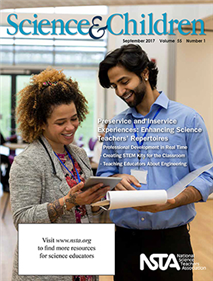All Phenomena resources
Journal Article
Science 102: Area of a Circle Conundrum
This column shares exercises to challenge content knowledge. This month's issue presents a new challenge and answers the Match Magic challenge from last month....
Blog Post
Gravitational Interactions and 3-D Learning in Middle School
I recently embarked on a journey with K–8 teachers in Vermont to learn how to be intentional about planning for three-dimensional (3-D) learning in the classroom....
By Cindy Workosky
Blog Post
Using Claim, Evidence, and Reasoning (CER) Strategy to Improve Student Learning
This past school year, I used claim, evidence, reasoning (CER) statements to show three-dimensional learning in my classroom. Several tools are available for doing this, but the one my students like is the CER Graphic Organizer and Transition Words L...
By Cindy Workosky
Blog Post
You Teach What? I’m So Sorry! Building a Better Body and Building Better Argumentation
I am always amazed at the looks on people’s faces when I tell them I teach middle school. They seem to pity me for having a position I chose and love! They inform me that middle school “tween-agers” are argumentative, stubborn, and at times, ad...
By Cindy Workosky
Journal Article
This column shares exercises to challenge content knowledge. This month's issue presents a new challenge and answers The Sound of One Hand Clapping challenge from last month....
Journal Article
Disequilibrium: How Heat Affects the Density of Water
This column shows how to use discrepant events to confront misconceptions. This month’s discrepant event illustrates what happens when a container filled with warmer, less dense water is placed on top of a container filled with denser, cooler water...
Blog Post
Why Anchoring Phenomena Are Important in the NGSS Classroom
Who is Ivor Robson, and why is he associated with anchoring phenomena? If you are a longtime golf aficionado, you know that Ivor Robson had a special role at the British Open. Robson spent 41 years introducing each player on the first tee, and he nev...
By Cindy Workosky
Blog Post
When I began aligning my instruction to the Next Generation Science Standards (NGSS), I got lost in the details. But when I realized that phenomena could be used to anchor linked disciplinary core ideas, I started to visualize the course as a whole a...
By Cindy Workosky
Blog Post
My ‘Phenomenal’ Journey in Elementary
I am the type of educator who gets very excited about new strategies, new and innovative technology, and new activities for students. However, I was more nervous about than excited about to choosing phenomena for my science units. I felt tremendous p...
By Cindy Workosky
Blog Post
At the core of a Next Generation Science Standards (NGSS) classroom is the sequence of exposing students to an interesting natural phenomenon, having students generate questions about the phenomenon, investigating student questions, then creating a s...
By Cindy Workosky
Blog Post
Introducing Crosscutting Concepts in the Elementary Grades
Four years ago, I moved from teaching middle school science to teaching grades 2–5 STEAM (science, technology, engineering, art, and mathematics) labs. One of the biggest challenges I faced was limited lab time in our elementary school. Because we ...
By Cindy Workosky
Blog Post
Planning Three-Dimensional Instruction
Knowing that content material is most engaging when students can relate to it, I always begin my year with a student survey. The questions are designed to help me design lessons to be as student-focused as possible. Knowing my students’ interests a...
By Cindy Workosky
Blog Post
Digging Deeper: Designing Solutions
This month’s Digging Deeper column for the Next Gen Navigator focuses on the practice of constructing explanations and designing solutions, and specifically the design process that addresses the engineering component of the Next Generation Science ...
By Cindy Workosky





